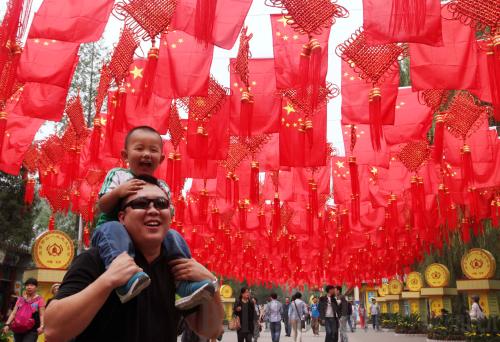

FESTIVE MOMENT: A father and his son visit the Badachu Park in Beijing on September 21, which has been decorated to celebrate the National Day on October 1 (CNSPHOTO)
When the People's Republic of China was founded on October 1, 1949, the new government inherited an economy that was overwhelmingly agrarian, ravaged by decades of warfare, and wracked by widespread poverty.
Many mines and factories had been damaged or destroyed. Transportation, communication, and power systems had been destroyed or had deteriorated because of lack of maintenance. Agriculture had been disrupted, and food production was significantly below its pre-war peak level. Furthermore, economic ills were compounded by one of the most virulent instances of inflation in global history.
Many observers of post-1949 China doubted whether the brand-new government could survive the economic chaos.
Progress driven by reforms
Sixty-five years later, the Chinese economy, regarded by many as the most dynamic in the world, is on track to become the No. 1 economy by sheer size.
According to official figures, China's outbound direct investment reached a record high of $108 billion in 2013, making it the world's third largest investor for the second year running. The annual growth rate of 22.8 percent was much higher than the 1.4-percent gain in global outbound investment.
Chinese e-commerce company Alibaba Group Holding Ltd. made the biggest stock market debut in history when it was listed at the New York Stock Exchange on September 19, raising a total of $21.8 billion and soaring 38 percent in its first session, as investors clamored for a piece of the company, representing a massive bet on the future growth of China's burgeoning middle class.
According to the latest Fortune Global 500 list, released in July, China saw 100 companies entering the list, securing the No.2 place in the number of companies on the list and marking the 11th year straight that the number of Chinese companies has increased.
In 2013, a Chinese bank, Industrial and Commercial Bank of China (ICBC), for the first time topped The Banker magazine's annual rankings of the profits and capital strength of the world's 1,000 largest banks. In the rankings released this July, the growth story of Chinese banks looks to be continuing unabated, with ICBC keeping its position as the strongest bank, and China's top banks accounting for almost one third of a record $920 billion of profits made by the world's top 1,000 banks last year.
The World Intellectual Property Organization (WIPO) said in March that the United States and China drove record-level patent-filing activity via WIPO in 2013 as the number of annual international patent applications surpassed the 200,000 mark for the first time. China, accounting for 29 percent of total growth under WIPO's Patent and Cooperation Treaty (PCT) system, overtook Germany to become the third largest user of the system.
"Reforms have profoundly and comprehensively transformed China. In retrospect, every major round of reforms has been promptly followed by a period of fast economic growth and social progress and whenever the socioeconomic development was met with difficulties and barriers, a new round of reforms was initiated in response," said Chi Fulin, President of the China Institute for Reform and Development.
Xiaogang, a small village in Fengyang County, east China's Anhui Province, is famous for representing the epitome of China's last round of rural reforms. It started with a secret arrangement among local farmers to subdivide their common farmland in December 1978, after which agricultural production increased dramatically. The village was then held up as a model by China's leadership in launching a national reform that made rural households contractors of farmland, and greatly incentivized agricultural production and productivity.
The reforms have transformed China's rural areas as well as people's lives in Xiaogang. Half of the families in this village now live in villas. Local farmers have in recent years built tourism facilities, including a museum related to the famous reform, to attract urban residents seeking a vacation getaway. The revenues from running vineyards and family-run hostels have boosted the local farmers' per-capita income to more than 12,000 yuan ($1,950) in 2013, compared to a mere 20 yuan ($3.2) in 1978.
After becoming the general secretary of the Communist Party of China (CPC) Central Committee in November 2012, Xi Jinping, who was elected Chinese president the following March, wasted no time in reassuring the world that the CPC will not only persevere with reforms championed by Deng Xiaoping, chief architect of China's reform and opening up, but also initiate new paths. Shenzhen, the special economic zone of south China's Guangdong Province that is synonymous with the country's 36-year-old era of reform drive, was the first city that Xi inspected after becoming the Party chief.
"I chose Guangdong because I intended to reflect on China's opening-up and reform progress on the site where the trend was first initiated," Xi recalled.
Copyright ©1999-2018
Chinanews.com. All rights reserved.
Reproduction in whole or in part without permission is prohibited.